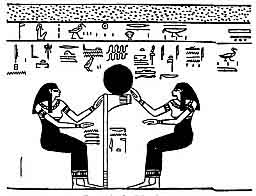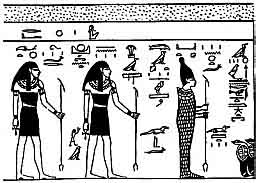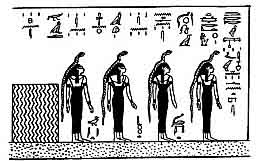
The Boat of Af, the dead Sun-god, in the Tenth Hour.
HAVING passed through the NINTH DIVISION of the Tuat, the boat of the sun arrives at the TENTH DIVISION, which is passed through by the sun during the TENTH HOUR of the night. The opening text reads:--
"This great god taketh up his place in this Circle, and he uttereth words to the gods who dwell therein.
The name of the door of this City through which this great god entereth is AA-KHERPU-MES-ARU. The name Of this City is METET-QA-UTCHEBU. The name of the hour of the night which guideth this great god to the hidden paths of this City is TENTENIT-UHESET-KHAK-ABU."
In the middle register are:--
1. The boat of the sun, in which the god stands under a canopy formed by the serpent Mehen; he

The Boat of Af, the dead Sun-god, in the Tenth Hour.
holds the symbol of life in his right hand, and a serpent, which serves as a sceptre, in his left.
2. A large two-headed serpent called THES-HRAU, which is depicted in the form of a pair of horns deeply curved towards the ends where they meet. The head which faces to the right has on it a White Crown, and is directly opposite to the face of a goddess, who also wears a White Crown, and is called
[paragraph continues] HERT-ERMENT, and the head which faces the left has on it a Red Crown, and is directly opposite to the face of a goddess, who also wears a Red Crown and is called SHEMERTI, i.e., "She of the two bows."
The Serpent is provided with two pairs of legs; one pair is turned to the right and the other to the left

(Left) Shemerti. (Center) The serpent Thes-hrau. (Right) Hert-erment.
Within the curve is a large hawk, which bears the, name of HERU-KHENTI. 1
3. A boat, wherein lies at full length the serpent ANKH-TA.
4. Four male figures, each of which has a disk in place of a head; each grasps in his right hand an arrow, with a spear-shaped head, which rests on his shoulder, and is pointed downwards; their names are:--
1. TEPTHRA.
2. SHESERA.
3. TE-MAU.
4. UTU.
5. Four bearded, human-headed figures, each of which has in his right hand a short spear, which rests
on his shoulder, and is pointed upwards; their names are:--
1. SETU.
2. ERTAU.
3. KHESEFU.
4. SEKENNU.

Setu. Ertau. Khesefu. Sekennu.

Petthi. Shemerthi. Thesu. Kha-a.
6. Four bearded, human-headed figures, each grasping with both hands a bow, which he holds above his knees; their names are:--
1. PETTHI,
2. SHEMERTHI.
3. THESU.
4. KHA-A.
The texts which refer to the above read:--1. "This great god maketh his journey through this City, in this picture, in his boat, and his sailors, who are the gods, convey him along; this [great] god taketh up his place in this City in the water, whereupon those who live in the water make use of their weapons, and they spring into life at the sound of the working of the sailors, who are gods, [in the boat of Ra]."
2. "Those who are in this picture are they who are on the two sides of THES-HRAU, who is the Soil of SEKRI, the governor of the TUAT. This figure (i.e., the serpent) even in the form in which it is, travelleth after this great god into its horizon,
and it entereth in with him in the earth every day."
3. "He who is in this picture in his boat standeth up in the thick darkness in the Hall of the Eastern Horizon, and he taketh up his position in his place every day; he formeth the serpent watcher of the Tuat in the holy place of KHENTI-AMENTI."
4. "To those who are in this picture with their arrows, and to those with javelins, and to those with their bows, who are in the presence of this great god, and who make their appearance with him in the Eastern Horizon of the sky, this great god saith:--Speed ye your arrows, make ready your javelins, bend your bows, and destroy ye for me my enemies who are in darkness; be ye at the portal of your horizon, and follow ye in my train when I unite myself to those who make adoration to my flesh in the MANTIT BOAT. It is, they who drive back the SEBI serpent of NEHA-HRA in the thick darkness, and when this great. god passeth on into the Eastern Hall of the horizon, they also travel on in the train of this god." Over the upper register runs a line of text, which reads:
[paragraph continues] "[This is] the hidden Circle of Amentet, where KHEPER uniteth himself to the form of Ra, and where the gods, and the spirits, and the dead hasten (?) in the hidden forms of AKERT. If a copy of these things be made according to the figures which are depicted on the east of the hidden chamber of the Tuat, and if [a man] knoweth it, together with the names [of the gods], he shall journey round about and shall pass through the Tuat, and he shall not be turned back from making himself a companion of Ra."
In the upper register are:--
1. The god PANKHI, who holds an ankh in his right hand, and a sceptre in his left.
2. A beetle, called KHEPER-ANKH, apparently pushing along a zone of sand,
 or perhaps entering the horizon. The text which refers to these scenes reads: "Those who are in this picture in the Tuat are in the forms of (i.e., they represent) the births of the god KHEPER, who is carrying his horizon to this
or perhaps entering the horizon. The text which refers to these scenes reads: "Those who are in this picture in the Tuat are in the forms of (i.e., they represent) the births of the god KHEPER, who is carrying his horizon to this
[paragraph continues] City, so that he may come forth into the Eastern Horizon of the sky."
Two serpents, standing on their tails, which cross each other near their tips. Their heads and necks are bent at right angles to their bodies, and in the space between them rests a disk; the serpents are called

(Left) P-ankhi. (Right) Kheper-ankh.
[paragraph continues] MENENUI. To the, right is a youthful goddess wearing a White Crown, and to the left is a similar goddess wearing a Red Crown each holds the index finger of one hand to her mouth, after the manner of children, and each is depicted in the act of sitting, but lacks a seat or throne.

The Menenui serpents and the goddesses of the South and North.

The axe of god and the solar disk.
4. An axe, symbol of "god," standing on the handle end, with a disk resting on the side edge of the head. On the left is a goddess who is steadying the axe with her left hand, and on the right is a goddess who is steadying the disk with her right hand; the names of the goddesses are NETHETH, and KENAT, respectively. Each goddess is depicted in the act of sitting, but lacks a seat or throne. The text which refers to these scenes reads: "Of those who are in this picture [the two goddesses on] the left come forth from the double serpent MANENUI, and [the two] on the right come forth from the axe SETFIT. They gather together the souls on earth, and they make pure the mighty spirits in the Tuat by the hidden figures which are therein, and [afterwards] they swallow their own spirits (or, souls) after this great god hath passed them by."
5. Eight goddesses, who stand upright, and hold an ankh
in their right hands, and a sceptre in their left; they face the ape god, whose tail is stiffened out under him in such a manner as to form a seat for him, and who holds the utchat, or eye of the sun, on his two hands. The first four of the goddesses have each the head of a lioness and are called:--
1 . SEKHET.
2. MENKERT.

Sekhet. Menkert. Huntheth. Usrit.
3. HUNTHETH,.
4. USRIT.
The remaining four have the heads of women, and have the names of
1. AMT-NETERU-S.
2. ARIT-TATHETH.
3. AHAT.
4. THEMATH-ERMEN.
The name of the ape-god is AF (?)-ERMEN-MAAT-F. Concerning the goddesses the text says:

Abet-neteru-s. Arit-Tatheth. Ahat. Themath-ermen (?).
[paragraph continues] "To these goddesses who make the
reckoning of his Eye for Horus in the Tuat, Ra saith:--'Make ye strong your spirits by means of [your] strength, and make the reckoning of his Eye for Horus, stablish ye his Eye for Horus, and make ye Horus to unite himself to his emanation (or, to that which floweth from his eyes), praise ye Horus by reason of his Eye, and stablish ye his first Eye which is in the hands of the god AF-ERMEN-MAAT-F, and utter ye your words on behalf of Horus, O ye who cause to come

(Left) Af-ermen-maat-f. (Center) Ermenui. (Right) Neb-aqet.
into being the becomings of created things.' The work which they do in the Tuat is to utter words on behalf of his Eye for Horus, and to cause radiant splendour to proceed from it each day."
6. Eight gods, each of the first seven of whom holds an ankh in his right hand, and (sceptre) in his left; their names are:--
1. ERMENUI, who has the double object in the place of a head.
2. NEB-AQET, jackal-headed.
3. AMEN-KHU, hawk-headed.
4. HER-SHETA-TAUI, man-headed.
5. SEM-HERU, man-headed.
6. AMEN (?)-HERU, man-headed.
7. KHENT-AST-F, man-headed.
8. KHENT-MENT-F, a god in mummied form, like Osiris, who wears a White Crown, and grasps a sceptre, with both hands, which project from his bandages.
The text which refers to these gods reads: "Those who are in this picture in the forms which Horus made-when this great god crieth out to them

(Left) Amen-khu. (Center) Her-sheta-taui. (Right) Sem-Heru.

(Left) Amen Heru. (Center) Khent-ast-f. (Right) Khent-ment-f.
by their names, they unite themselves and come into life in the shades which are in the mouth of the great god, and their souls journey onwards in his train to the horizon. They strip the bodies of the dead of their swathings and break in pieces the bodies of the enemies [of Ra], and they give the order for their destruction in the Tuat."
In the lower register are:--
1. The god Horus, hawk-headed and wearing a disk, leaning on a staff.
2. Five 1 lakes of water, in each of which is submerged a male form; these figures are called the "submerged."
3. Three 2 lakes of water, in each of which is a male form swimming, turned over on his breast; these are called the "swimmers."
4. Four lakes of water, in each of which is a male form floating on his back; these are called the floaters," The text reads: ###.
[paragraph continues] The above text is full of lacunae, and whole passages, consisting of several lines, are wanting; the following version from Lanzone's edition (Le Domicile des Esprits, pl. ii.) will be found useful in obtaining an idea of the contents of the legends which accompanied the lakes of water:
"Horus saith unto those who have plunged themselves beneath the waters, and unto those who swim, and unto those who float in NU of the Tuat, 'O ye who have plunged yourselves beneath the waters, who shine in Nu, O ye whose hands cover your faces, who swim with your faces turned towards the water in the Tuat, whose cheeks are filled with water, O ye who paddle in the waters of Nu, whose faces are turned up into
the air in the following of your souls, whose souls have been deprived of their heavenly air, and who beat the air with your hands in order to obtain it, O make ye your way in Nu by means of your legs, and your thighs shall not be in any way impeded. Come ye forth in this stream, descend ye on these waves, fill ye HAP-UR, and arrive ye at its furrows,

Hetemit. Bekhkhit. Tchetmit. Senthes.
for your members shall not perish, and your flesh shall not decay, and ye shall have dominion over your water, and ye shall have abundance according to my command, O ye whose duty it is to dwell in Nu, together with those who have plunged themselves beneath the waters, and are in [his] following, and whose souls have life."
5. A lake of water.
6. Four female figures, each bearing a serpent on her head and shoulders; the head of each reptile is raised above the head of its bearer, and its tail hangs down her back; their names are:--
1. HETEMIT.
2. BEKHKHIT.
3. TCHETMIT.
4. SENTHES.
The text reads:
[paragraph continues] "Those who are in this picture are they whose forms (or, figures) live by their heads. It is they who shed light upon the road of Ra in the thick darkness, and when he cometh forth into the Hall of the East, SET waketh up and travelleth on with him."
7. A sceptre, surmounted by the head of Set; its name is SET-NEHES, i.e., "Set who wakens."
209:1 Or, KHENT-HERU, which became one of the Dekans among the Greeks, i.e., χοντάρ see Maspero, op. cit., p. 127.
224:1 These should be four in number.
224:2 These should be four in number.
Next: Chapter XI. The Eleventh Division of the Tuat, Which Is Called Re-En-Qerert-Apt-Khatu